Enhancing Indoor Gardening with Glass Display Cabinets
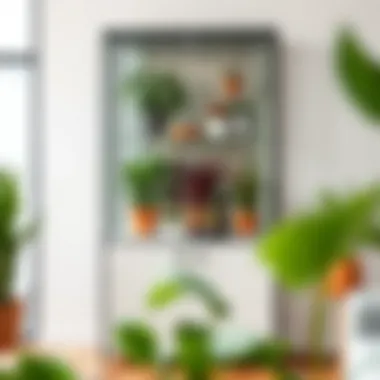
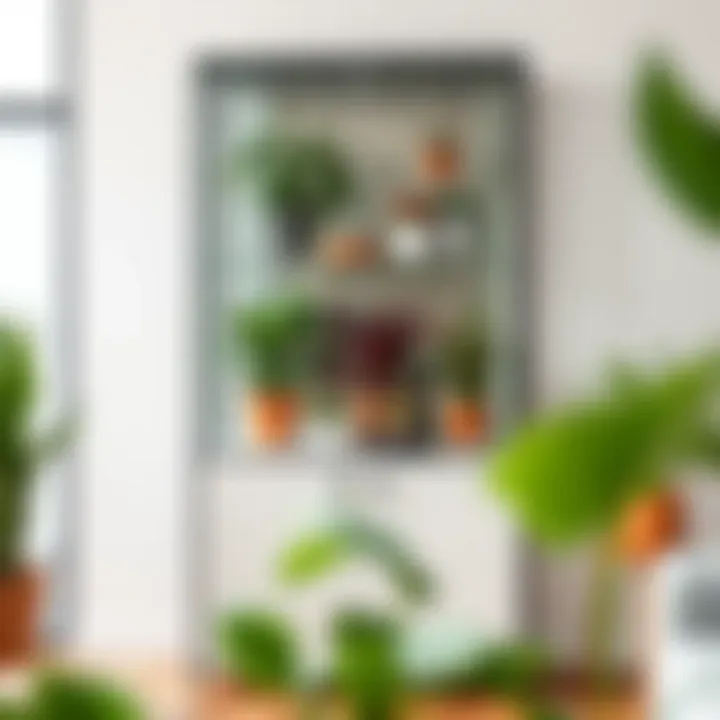
Intro
Creating a vibrant indoor garden is more than just a hobby for many plant enthusiasts; it’s a way of life. Glass display cabinets have become key players in this world, serving not only as practical storage, but also as stunning showcases for cherished plant collections. These cabinets act as a bridge between plants and their environment, making it easier to maintain optimal conditions while also amplifying the visual splendor.
Understanding the role of glass display cabinets involves looking through three primary lenses: the aesthetic enhancements they provide, the functionality they offer, and the practicality concerning plant care. With the right cabinet, plants can thrive in a controlled setting that highlights their unique traits. As the demand for unique indoor gardening solutions grows, recognizing the significance of these glass structures becomes vital for every plant lover.
This article unpacks the intricate aspects of glass display cabinets, from design inspiration to practical advice on maintenance, ensuring plant enthusiasts can make informed choices. Whether you're a seasoned gardener or a DIY decorator, there is something here that will resonate with your aspirations to create an inviting and lush indoor landscape.
Foreword
In the world of indoor gardening, glass display cabinets serve a unique and multifunctional purpose. Not only do they provide a stunning visual centerpiece, but they also cater directly to the needs of plant enthusiasts. Imagine having a beautiful collection of greenery that is highlighted by elegant glass showcases. It transforms any space into a living gallery, sparking curiosity and admiration from all who enter.
Why should one consider these cabinets?
First, glass display cabinets effectively protect delicate plants from harsh environmental conditions. They shield your greens from temperature fluctuations, excessive humidity, or drafts, allowing the plants to thrive in a more stable environment. Additionally, the transparent structure of these cabinets serves a practical purpose: it allows for natural light to filter through, offering essential sunlight to your plants while still providing a protective barrier.
Moreover, there are aesthetic benefits that cannot be overlooked. A well-designed cabinet becomes a focal point, adding sophistication to a room. With diverse styles ranging from modern sleek designs to vintage charm, there is a display cabinet for every taste and decor style. Homeowners and designers alike can integrate these cabinets into their spaces, creating visual harmony that uplifts their interiors.
It's important to consider the myriad of designs, materials, and technologies available in the market. Knowledge of these aspects can significantly enhance the user experience and can elevate not just the beauty of your home but also the health of your plants. This article navigates through the different functionalities of glass display cabinets, explores design considerations, and offers insights into how these elegant structures can transform your plant collection into a statement piece.
"A plant's beauty lies not only in its characteristics but in how it's showcased."
By the end of this article, you will have a comprehensive understanding of how to select the right cabinet for your needs—whether you are a novice plant parent or an experienced green thumb—and appreciate the impact glass display cabinets can have on your indoor garden life.
The Functionality of Glass Display Cabinets
Glass display cabinets serve more than just an aesthetic purpose in the realm of indoor gardening. They provide numerous functional benefits that can enhance the health and visibility of a plant collection. Understanding these aspects is essential, particularly for those who are passionate about plants and want to create a tailored environment that promotes growth and longevity.
Preservation of Plant Health
Maintaining a delicate balance in the care of plants is key to their survival and vibrancy. Glass display cabinets can significantly contribute to this. Their transparent structure allows sunlight to penetrate, which is crucial for photosynthesis. Well-placed plants inside these cabinets receive ample light exposure without having to compete with other houseplants or outdoor elements, providing conditions similar to a greenhouse.
Moreover, by enclosing plants, you minimize their exposure to temperature fluctuations. A glass cabinet maintains a more stable microclimate which can be warmer and more humid than surrounding areas, helping to retain moisture that many tropical plants thrive on.
Benefits of Plant Health Preservation in Glass Cabinets:
- Enhanced light intake leading to improved growth.
- Temperature stability shields plants from external weather variations.
- Higher humidity retention suits tropical species.
Protection from Pests and Elements
Plants can be an easy target for pests like aphids, spider mites, and fungus gnats, especially when kept in open spaces. Glass display cabinets act like a fortress against these uninvited guests. The enclosed space creates a barrier that reduces the chances of infestation from outside sources.
Additionally, since these cabinets can protect plants from elements such as wind and rain, they also serve to prevent physical damage that can occur outdoors. The structured walls mean that plants won’t experience direct exposure to harsh sunlight or sudden rain showers which can lead to waterlogged soil or sunburned leaves.
Features of Pests and Element Protection:
- Blocks entry points for pests.
- Guards against harsh weather and fluctuations in humidity.
- Reduces the risk of soil contaminants from the outside.
Creating a Controlled Environment
A significant advantage of using glass display cabinets is the ability to create a controlled environment tailored specifically for your plants. With the right setup, you can regulate temperature, humidity, and even light levels, optimizing them according to the needs of different species. For instance, some plants thrive in high humidity while others prefer dryer conditions. A cabinet allows you to customize these variables easily.
Investing in features such as adjustable shelving can further facilitate this process. This way, the taller plants could bask in the highest light whilst the smaller ones find their perfect spot in lower levels. As a result, it becomes simpler to accommodate a diverse range of plant species without overcrowding.
Key Elements for a Controlled Environment:
- Adjustable lighting options.
- Shelves designed to accommodate different plant heights.
- Humidity monitors to keep an eye on moisture levels.
Design Considerations
When choosing glass display cabinets for plants, the design goes far beyond aesthetics. It plays a pivotal role in functionality, ensuring that both the plants and the environment in which they thrive are taken into account. Getting the design right can significantly impact plant health, ease of maintenance, and the visual harmony within your space. The considerations involved in designing a cabinet are multifaceted, touching on elements such as materials, dimensions, and overall style. Let's delve into these important aspects.
Material Choices
Glass Types
When it comes to glass options, one major choice is between tempered glass and acrylic. Tempered glass is known for its strength and durability, making it an ideal choice for display cabinets situated in busy areas. It can withstand higher temperatures, which is a bonus if you are integrating lighting systems that emit heat. Its clarity also provides a crystal-clear view of your plant collection. However, tempered glass can be heavier and more challenging to work with during installation. On the flip side, acrylic is lightweight and offers excellent insulation, but it can scratch more easily. Each type has a unique feature—temperate glass provides sturdiness while acrylic offers adaptability—making your choice an important one.
Frame Materials

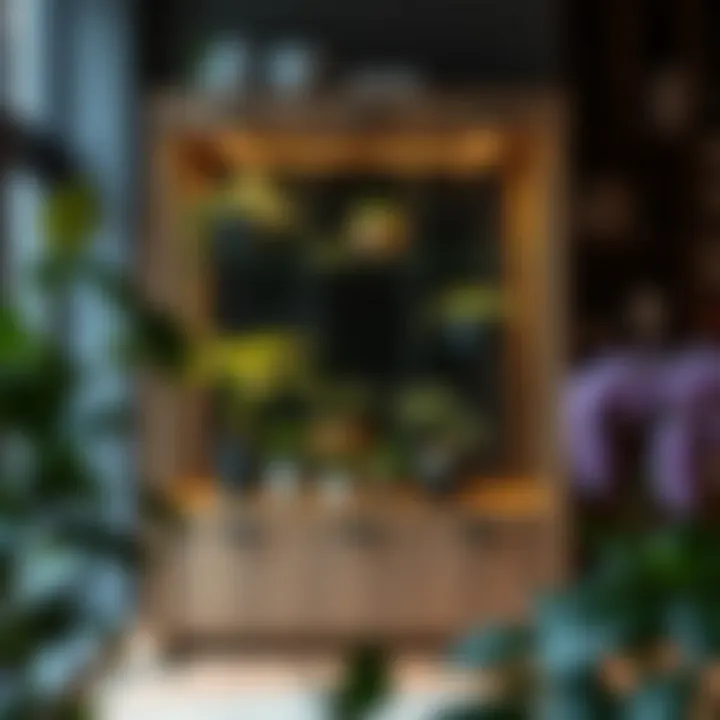
The frame of your display cabinet can be constructed from a variety of materials such as wood, metal, or a combination of both. Wooden frames can enrich a natural aesthetic, providing warmth and a rustic touch to the environment. They can be custom-built to fit specific dimensions, which can be a considerable advantage for non-standard spaces. However, reliance on wood necessitates careful treatment to prevent warping or decay from humidity. Metal frames, on the other hand, usually offer a sleek, modern appearance and higher strength but can be prone to rust if not properly coated. Each frame type carries its own benefits—wood adds character, while metals provide a structured feel.
Sustainable Options
In recent years, environmentally friendly options have found their way into the design realm. Sustainable materials, like bamboo or reclaimed wood, offer not only breathtaking aesthetics but also contribute to eco-friendliness. Such materials can make an impressive statement while aligning with the growing emphasis on sustainability in home decor. Their unique features often entail natural variations which can give cabinets a one-of-a-kind look. However, sourcing sustainable materials can sometimes be more costly and may take longer to find depending on availability. All in all, choosing sustainable options reflects a commitment to environmental stewardship, appealing to many conscientious plant lovers.
Size and Dimensions
Selecting the Right Size
Selecting the correct size for your display cabinet is crucial for the well-being and appearance of your plant collection. If a cabinet is too small, it can restrict growth; if too large, it may overwhelm a space or become unwieldy when moving it. A key characteristic in determining size is the variety and number of plants you plan to display. A cabinet that accommodates a spectrum of sizes within your collection will create a more visually balanced look. Besides visual appeal, a well-sized cabinet can also help improve air circulation and light exposure for the plants, so consider these elements when making your decision.
Vertical vs. Horizontal Space
In cramped quarters, the decision between vertical or horizontal space can make all the difference. Vertical cabinets can maximize space upward, allowing multiple tiers for plants, which is often ideal for smaller rooms. This arrangement takes advantage of light levels effectively. Horizontal cabinets, however, can be more user-friendly for accessing plants and can serve as convenient surfaces for displaying gardening books or decorative items. Each orientation has distinct advantages; choose the one that best meets your spatial constraints and personal preferences.
Style and Aesthetic Integration
Modern Designs
Modern designs focus on streamlined profiles and minimal clutter, often employing sleek finishes and clean lines. These designs seamlessly blend into contemporary settings and can highlight the beauty of your plant collection without overpowering it. A modern display cabinet often incorporates monochromatic colors and geometric shapes, allowing plants to take center stage. However, this simplicity can sometimes lean towards being cold or sterile, lacking the coziness many people desire.
Vintage Appeal
On the other hand, vintage appeal brings a story into your home with its ornate details and rustic finishes. It often features reclaimed materials or classic designs that add character and charm to any room. Such cabinets can create a warm, inviting atmosphere that resonates deeply with many people. While they can present a more homey feel, the challenge lies in keeping them maintained as older materials might require special care and attention to preserve their look.
Custom Options
For those who seek something uniquely tailored, custom options can truly bring a personal touch to your home. Custom cabinets can be designed to meet specific dimensions, styles, or functions according to your needs. Whether it’s a specific color palette that matches your interior or features that accommodate particular plants, the possibilities are boundless. The main downside of custom options tends to be a higher cost due to the tailored craftsmanship involved. Yet, investing in something tailored can yield resonating satisfaction as it reflects your individual tastes.
Considering these aspects in design will help you create a functional and aesthetically pleasing display cabinet for your plants, making them not just decorations but true highlights of your living space.
Plant Selection for Display Cabinets
Selecting the right plants for glass display cabinets is no small feat. The plants you choose can make or break the look and functionality of your indoor oasis. It's essential to consider not just aesthetics, but also the needs of each plant species. Plants grown in these cabinets require not only good light but also the right amount of humidity and protection from pests. Failing to select suitable species can lead to a disappointing display that may not thrive, reducing the overall beauty and health of your collection.
Understanding the specific requirements of different plants is paramount. Some plants, like succulents, do well in drier conditions, while others, such as ferns, crave high humidity. When selecting hosts for your glass cabinet, always think about how their needs will harmonize within the limited confines of glass. You can create a flourishing indoor jungle that not only catches the eye but also thrives under the right conditions.
Choosing Suitable Species
Choosing plants that are not only visually appealing but also suitable for the environment of a display cabinet is crucial. Make sure to pick plants that can thrive in lower light or indirect light, given that many cabinets may not always get direct sunlight. Plants such as pothos, snake plants, and peace lilies can be excellent choices due to their hardy nature and low light preferences.
Additionally, consider plants with unique textures or colors that will stand out against the glass. This visual variety can create a more dynamic look, setting your display apart. It's also beneficial to select plants known for air-purifying qualities. This way, you not only beautify your interior but also improve air quality, which is a nice little bonus for your home.
Layering and Arrangement Techniques
Arranging plants artfully fosters a captivating display while ensuring that each plant receives its share of light and resources. Layering and arrangement techniques are key to achieving that aesthetically pleasing look.
The Rule of Thirds
The Rule of Thirds is a fundamental design principle that encourages even distribution of visual elements in your display. By breaking the space into thirds, both horizontally and vertically, you can create a more balanced and pleasing arrangement. It allows you to showcase the unique features of various plants without overwhelming the viewer.
- Key Characteristic: This technique encourages variation and prevents monotony in a display.
- Benefits: Using this rule ensures that every section of the cabinet catches the eye and provides an engaging view from different angles.
- Unique Feature: It prompts you to think creatively about plant positioning, encouraging thoughtful combinations rather than random placements.
- Disadvantages: It could limit choices if the plants do not conform to the ruled spaces. Being too strict can stifle creativity.
Height Variation
Height Variation is an essential aspect when creating a visually appealing display. Varying plant heights allows for depth and intrigue in your cabinet. Taller plants can serve as backdrops, while shorter ones can populate the foreground, creating a rich tapestry of foliage.
- Key Characteristic: Presents an opportunity for layering and shaping the visual landscape of your cabinet.
- Benefits: Adding height variation can make the display look fuller and more organic, mimicking a natural environment.
- Unique Feature: It allows for dramatic contrasts in textures and forms, making each plant distinct yet interconnected within the arrangement.
- Disadvantages: Taller plants might obstruct the view of shorter species if not arranged thoughtfully, so planning is crucial.
Lighting Systems for Glass Cabinets
In the realm of cultivating plants in glass display cabinets, lighting systems are not just an accessory; they're essential. Proper lighting can drastically influence not only the health of the plants but also their aesthetic appeal. Glass cabinets can indeed create a universe of their own, but without the right light exposure, the vibrant greens can quickly turn to lifeless hues. With many plant species requiring specific light conditions, understanding the nuances of both natural and artificial lighting becomes key.
Natural Light Considerations
When it comes to natural light, orientation plays a crucial role. East-facing windows provide gentle morning light, while south-facing placements can expose plants to more vigorous rays throughout the day. However, care must be taken; too much direct sunlight can scorch leaves. Using sheer curtains to diffuse harsh rays can create a well-balanced environment. Additionally, consider the varying seasons. Light intensity shifts, and what worked in summer may not be ideal in winter. Therefore, rotating your cabinet or the plants within it can help ensure even light exposure.
Artificial Lighting Solutions
Artificial lighting solutions step in as a reliable alternative to supplement or replace natural light. They ensure that plants thrive regardless of the haze or seasons outside. LED grow lights are prominently featured in contemporary indoor gardening, owing to their efficiency and versatility.
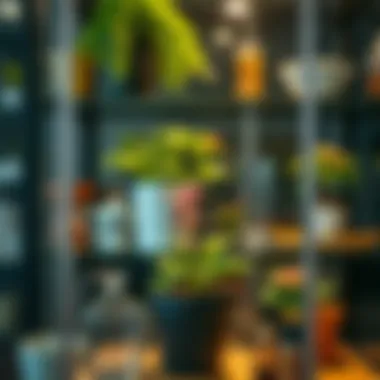
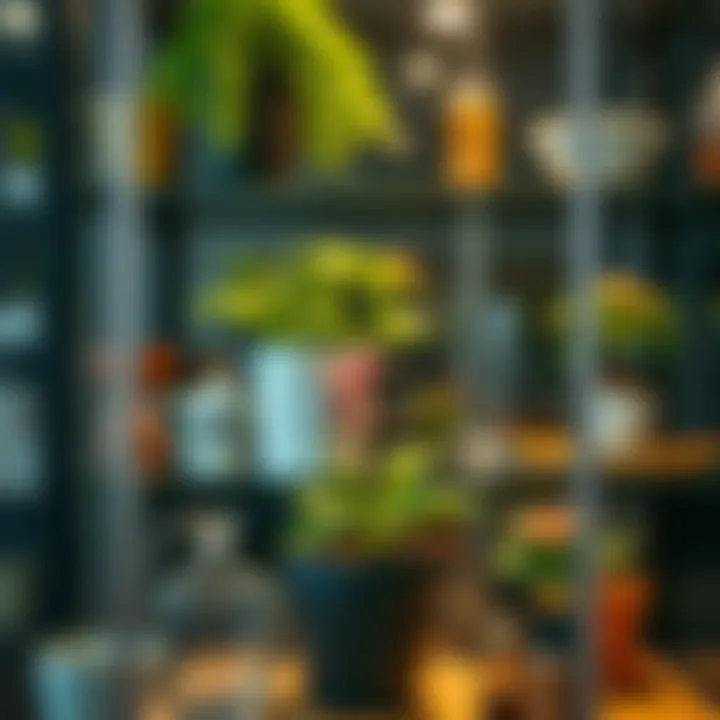
LED Grow Lights
LED grow lights shine as the leading choice among plant enthusiasts. Their energy efficiency is one of their standout traits; they consume less electricity compared to traditional bulbs. Plus, they produce minimal heat, reducing the risk of burning plants. A significant feature of LED grow lights is their spectrum customization; different plants can benefit from different light spectrums during various growth stages. For example, the blue light promotes vegetative growth, while red light encourages flowering. However, they can be a bit pricey upfront. Still, the long-lasting nature and reduced energy costs often justify the initial investment.
Heat Emission Considerations
Understanding heat emission considerations is equally critical. High heat levels can dehydrate plants and stress them out, leading to wilting and stunted growth. Many artificial lights generate warmth, and without proper ventilation, a glass cabinet could become a thermal oven for its green inhabitants. A unique edge of LED lights is their cooler operating temperature, which helps in maintaining a stable environment. It’s a delicate balance; while plants need warmth to thrive, too much heat can compromise their health.
"Light is to the plant what food is to the human. Without it, life and growth stagnate, leading to dull colors and weak strengths."
In summation, whether opting for natural lighting or a more sophisticated artificial setup, understanding the light requirements becomes crucial for maintaining a flourishing plant collection within glass cabinets. Knowing which systems to utilize not only helps in plant health but also enhances the overall aesthetic appeal of indoor spaces.
Maintenance and Care Techniques
Maintaining and caring for glass display cabinets is just as essential as selecting the right cabinet for your greenery. This section dives into cleaning methods, frequency recommendations, and the vital signs to keep an eye on when looking after your plants.
Cleaning and Upkeep
Having a clean display cabinet not only enhances the aesthetic appeal but also ensures that your plants receive the best possible environment for growth. A pinch of dust or smudge can obstruct the light that your plants thrive on, making the cleaning process non-negotiable.
Best Cleaning Products
When it comes to cleaning your glass display cabinet, choosing the right products cannot be overstated. Opting for a non-toxic glass cleaner is ideal. Many enthusiasts recommend products like Windex or Seventh Generation Glass Cleaner.
One key characteristic of non-toxic cleaners is their lack of harsh chemicals, making them safe for both plants and people. The unique feature here is that they don’t leave harmful residues that could potentially harm your plants. However, while these products are effective, be cautious about the quantity you use. Over-application can lead to streaks if not wiped away properly.
Frequency Recommendations
Frequency is your best friend in maintaining clean glass. Ideally, you should aim to give your cabinet a thorough cleaning every two weeks. This not only helps in keeping your plants’ environment pristine but also promotes good airflow within the cabinet. However, if your cabinet is positioned in a high-traffic area, adjusting this to weekly cleanings may be beneficial.
Another aspect to consider is the changing of seasons. With dust and pollen building up in spring, one might need to increase the frequency during that time. Using a schedule helps avoid any buildup that could affect plant health.
Monitoring Plant Health
Keeping tabs on the health of your plants is paramount, as it guards against not only premature wear and tear of your plants but also the cleanliness of your cabinet. Signs of distress can often be subtle, thus regular monitoring enables you to catch issues before they escalate.
Signs of Overwatering
One significant issue plant lovers face is overwatering, a notorious problem that can silently wreak havoc. It’s crucial to recognize the telltale signs: yellowing leaves, wilting, or that dreaded mushy texture can all point to too much water.
Identifying these symptoms early gives you the chance to rectify the situation, perhaps by allowing the soil to dry out sufficiently or checking the drainage holes for blockages. A key characteristic of plants in distress shows itself physically, which means attention is essential for healthy growth. Ignoring these signs can lead to root rot, causing irreversible damage.
Pest Control Measures
When plants are confined to a glass display cabinet, they can sometimes attract pests. Monitoring for signs of pests such as webbing or tiny holes in leaves is a must. Implementing pest control measures that are safe for the plants is vital. Consider using insecticidal soap or neem oil as effective options.
A significant advantage of these products is their gentle nature on most plants, not to mention they cater to a wide range of common pests. Regularly inspecting plants can help catch infestations early, ensuring your plant display remains vibrant and healthy.
"Proper maintenance not only preserves the beauty of your display but nurtures the life within it."
In summary, well-rounded maintenance not only elevates your plant collection's aesthetics but also significantly contributes to their health. Regular cleaning and vigilant monitoring foster an environment where both plants and collectors flourish.
The Aesthetic Impact of Display Cabinets
When it comes to creating a welcoming and visually appealing space, the role of glass display cabinets in showcasing plants cannot be overstated. These cabinets do more than merely serve as containers; they transform ordinary plants into extraordinary focal points within a room. This section digs into how these display solutions can play a key part in enhancing the aesthetic value of your indoor environment.
Enhancing Interior Spaces
Integrating glass display cabinets into your home’s interior design can elevate the overall ambiance significantly.
- Sleek Transparency: Unlike opaque cabinets, glass allows for unobstructed views of the plants inside. This transparency can create an illusion of space, making a room feel larger and airier. Particularly in smaller areas, a well-placed cabinet can provide substance without overcrowding.
- Color Play: Different plants, with their rich greens and vibrant flowers, contribute color to a space. A well-lighted glass cabinet serves as a showcase, highlighting these hues and creating a pleasing contrast with walls and furniture. Plants like Calathea or Anthurium become art pieces rather than just house plants.
- Style Versatility: Glass cabinets come in a variety of styles—modern, vintage, and more. This flexibility means they can fit seamlessly into any decor theme. A minimalist glass display may accentuate contemporary aesthetics, while a more ornate cabinet could add charm to a rustic setting. Selecting one that aligns with your overall design can enhance cohesion in your space.
Maintaining visual harmony in your home does not need to be a daunting task when it comes to plant displays. A glass cabinet can easily meld into the existing landscape of your interior spaces, making it a versatile choice for enthusiasts.
Creating Focal Points
Focal points guide the eye and pull together a room’s design, and glass display cabinets can serve as striking centers of attention. Here are some ways these cabinets help establish focal points:
- Strategic Placement: Positioning a display cabinet in a spot where light naturally falls can enhance the colors and textures of the plants inside. For example, a beautifully illuminated cabinet near a sunlit window creates a soft, atmospheric quality that draws interest.
- Layering Plants: Using varied heights and types of plants within the cabinet can generate intrigue. Smaller specimens in front can allow larger plants to stand out, catching the viewer's gaze. Species like Pothos or Ferns may cascade over the sides, creating drama while remaining elegant.
- Artistic Displays: Incorporating decorative stones, pieces of driftwood, or even snow globes alongside plants adds an artistic layer to the interior. This not only magnifies the beauty of the plants but also reflects the owner's personality and style.
To make a statement, consider a beautifully arranged cabinet adorned with vibrant greenery—making it not just a display for plants, but a true piece of living art in your home.
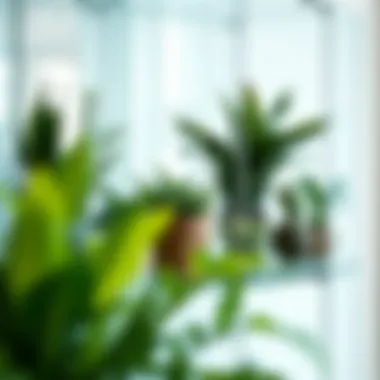
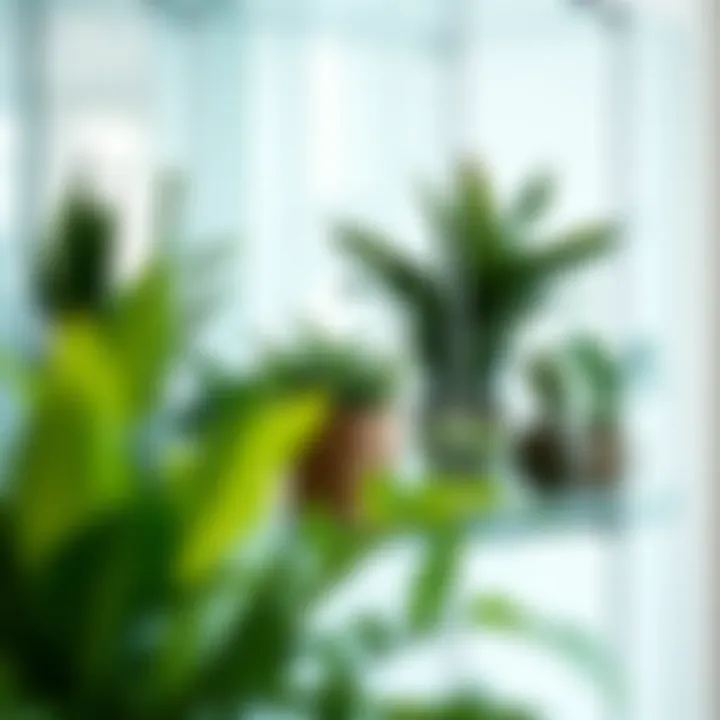
"A well-designed display cabinet does more than hold plants; it acts as a gallery for nature's artistry, inviting admiration and dialogue."
By meticulously choosing which plants to feature and how to arrange them, a glass display cabinet can embrace a room with beauty while remaining functional. Homeowners, designers, and decorators alike can appreciate the solid impact these cabinets can have on aesthetics, providing a wonderful blend of form and function.
Technological Integration
Integrating technology into glass display cabinets marks a significant leap forward for plant enthusiasts. This blend of nature and innovation provides essential means for promoting plant health, optimizing growth, and easing maintenance. When you consider how demanding indoor gardening can be, the incorporation of technology becomes almost a necessity for those aiming for thriving plants. It allows both novice and seasoned enthusiasts to cultivate their collections with confidence and efficiency.
Smart Cabinets and Automation
Smart cabinets are revolutionizing how we approach indoor gardening. Equipped with sensors, these cabinets can adjust light levels, humidity, and temperature, making sure that plants enjoy the best possible conditions. For instance, imagine a cabinet that can adjust its internal environment based on the specific needs of the plants within it. Varieties like the Monstera or Fiddle Leaf Fig each have unique preferences. A smart cabinet can help mitigate the guesswork involved in plant care.
Benefits of Smart Cabinets:
- Real-Time Monitoring: Constantly tracks environmental conditions and sends alerts to your smartphone if any parameters fall outside the desired range.
- Automated Adjustments: It can modify humidity levels automatically, like a HVAC system but for your plants, minimizing the need for manual intervention.
- Energy Efficiency: Smart systems optimize energy use, reducing costs and making them friendly to the environment.
One could argue that the deployment of such technology makes plant care more accessible than ever, allowing more individuals to explore the world of indoor gardening without prior expertise.
"The future of indoor gardening is bright, not just because of sunlight but also because of smart technology that works behind the scenes to support our green companions."
Monitoring Systems for Humidity and Light
In the world of plants, understanding light and humidity is crucial. Without adequate moisture or lighting conditions, even the hardiest plants can falter. Monitoring systems play a vital role here, ensuring that your indoor garden remains balanced and thriving.
Key Components of Monitoring Systems:
- Humidity Sensors: These tools measure moisture content in the air. Optimal humidity levels vary by species but generally lie in the range of 40-60%. For example, tropical plants often thrive in higher humidity levels. Sensors can trigger misters to maintain adequate moisture.
- Light Meters: Light sensors measure the intensity of light. Certain plants, such as succulents, prefer high light, while others, like ferns, thrive in low light conditions. A smart monitoring system can adjust artificial lighting to fit these preferences.
- Data Logging: Many modern monitoring systems offer data tracking. This provides insight into how environmental conditions correlate with plant health over time, allowing for informed adjustments in care routines.
The combination of these systems creates a feedback loop that promotes healthier plants and gives owners peace of mind.
As technology continues to evolve, these innovations present a compelling case for integrating technological solutions into the realm of indoor gardening. The complexities of nurturing plants may feel less daunting with the clever application of smart technology, leading to flourishing plant displays that adorn living spaces.
Trends in Glass Display Cabinets
As indoor gardening continues to pick up steam, trends in glass display cabinets have evolved significantly. These cabinets are not just mere containers for plants anymore. They have become key elements in the overall design and functionality of indoor botanical displays. Emphasizing the aesthetic value, structural integrity, and user-focused features, the latest trends are firmly rooted in sustainability and customization.
Sustainable Materials and Design
When it comes to designing glass display cabinets, sustainability has taken center stage. Homeowners and designers alike are becoming increasingly aware of the environmental footprint of their choices. Popular materials now include recycled glass and sustainably sourced wood for frames. These options not only contribute positively toward conserving resources, but they also elevate the visual appeal of the cabinets.
For instance, cabinets featuring bamboo frames are slowly gaining traction. Bamboo isn't just aesthetically pleasing; it also grows rapidly, making it an eco-friendly alternative. Using such materials showcases a commitment to green design and provides consumers with guilt-free options.
Additionally, eco-conscious finishes, such as low-VOC paints and stains, ensure that harmful chemicals don’t linger in the indoor atmosphere.
Here’s what to keep in mind when selecting materials:
- Durability: Ensure the materials are robust enough to support the weight of the plants and soil.
- Appearance: Choose materials that blend well with existing decor.
- Price points: Understand what you’re willing to invest in sustainable options; some may be pricier but offer longevity.
"Sustainability isn’t just a trend; it’s a lifestyle choice that fits seamlessly into every aspect of interior design."
Custom and Personalized Cabinets
If there’s one thing that truly sets today's glass display cabinets apart, it’s customization. Homeowners want their cabinets to reflect their personal style and fit their unique spaces. This could range from custom dimensions to built-in hydration systems, allowing for a tailored approach to plant care.
Considerations for personalized cabinets often include:
- Size Adjustments: Many enthusiasts want a cabinet that fits snugly in a particular area, whether it be a small nook or a spacious corner. Customization can make this possible.
- Color Choices: Choosing your favorite colors can also play a vital role in aesthetic appeal. From classic woods to vibrant lacquer finishes, your cabinet can become a visual extension of your personality.
- Organizational Features: Adjustable shelving systems are becoming popular. They offer flexibility to change the layout as the plant collection evolves.
Moreover, integrating tech features like smart irrigation systems can be a game changer, transforming a simple cabinet into a self-sustaining ecosystem. Some cabinets are now being equipped with sensors to measure humidity and soil moisture, alerting owners when their plants need attention.
By investing in a unique piece, you aren’t just enhancing your interior space but also creating an environment where your plants can flourish, reflecting the care you put into both aesthetics and functionality.
In summary, the ongoing trends in glass display cabinets signify a shift towards responsible design and individuality. Whether through eco-friendly materials or customized options, the choices available today encourage plant enthusiasts to create personalized sanctuaries that celebrate their botanical passions.
End
In examining the role of glass display cabinets in cultivating plant collections, it is evident that these structures are much more than decorative features in our homes. They serve pivotal functions that contribute not only to plant health but also to the overall aesthetic appeal of indoor spaces. A well-designed display cabinet can create a microclimate, enabling optimal growth conditions while offering protection from environmental hazards and pests.
One of the most compelling aspects discussed in this article is the balance between functionality and style. The right display cabinet enhances the visual impact of your plant collection, turning it into a striking focal point within the room. Homeowners and designers alike can appreciate how a thoughtfully integrated display can tie together various design elements in a space, making it cohesive and inviting.
Additionally, choices in materials and sizes discussed previously highlight the diverse options available to suit different tastes and needs. From sleek, modern designs made of tempered glass to vintage-inspired wooden-framed options, the possibilities are limited only by creativity and intention. Custom options further allow enthusiasts to express their unique styles while still offering a practical solution for plant display.
Benefits of Glass Display Cabinets for Plan Enthusiasts:
- Preservation of Plant Health: Cabinets help to maintain humidity and temperature, which can nurture delicate species.
- Protection from Pests: Keeping plants enclosed protects them from unwanted pests that can damage leaves and roots.
- Enhanced Aesthetic Appeal: A well-arranged cabinet elevates the home decor, adding a splash of nature to living spaces.
- Technological Integration: Modern display cabinets can now be equipped with smart technology to monitor plant needs, making care simpler.
All these elements converge to underscore the importance of glass display cabinets for plant lovers. They not only provide practical solutions for growing and showcasing plants but also enhance the quality of life by bringing nature indoors. In an age where sustainability is key, these cabinets promote a greener lifestyle while ensuring the enjoyment that comes from nurturing plants. Thus, for any homeowner, designer, or enthusiast, investing in a quality glass display cabinet might just be one of the best decisions when it comes to indoor gardening.



